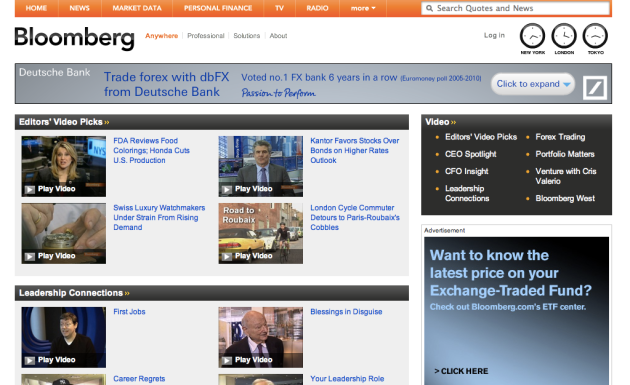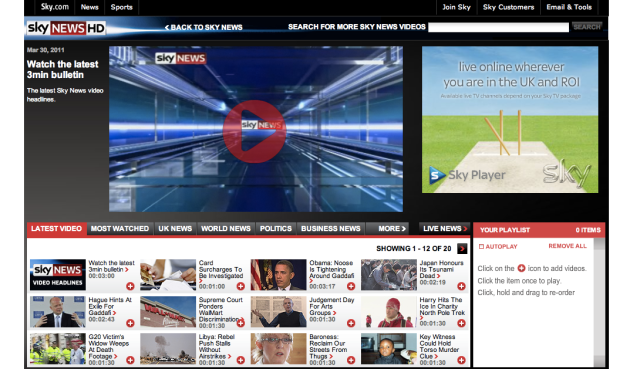Live event blogging: when text and video come together
March 30, 2011 Leave a comment
Live event blogging was originally conceived as a substitute for video coverage- a way of keeping web users up to date in the absence of any pictures.
It started in the mainstream sphere through sports coverage- a chance for people in the office or without Sky to access some form of coverage.
Its success is clear- a simple look at the Guardian Sport website shows that whenever live sport ‘minute by minute’ coverage has been available on any given day, it invariably is one of the most read items. As you can see from the image (right) – today’s live coverage of the India vs Pakistan cricket World Cup match is the most viewed page in the sports section.
More recently the phenomenon has moved to news coverage. Staying with guardian.co.uk, they are currently running Middle East daily live blogs, as well as their regular politics live feed.
But, crucially, video content and live blogging do no have to exist entirely in separation; particularly in journalism, where holding the rights to various sports’ is not necessary to stream video content.
This screenshot from bbc.co.uk demonstrates how successfully text and video can be integrated into live event coverage
 Here, text, graphics and tweets are used to augment video feeds from BBC World and the BBC News Channel, to add an extra dimension to the news coverage. Additional reports and viewer feedback further build on the video journalism.
Here, text, graphics and tweets are used to augment video feeds from BBC World and the BBC News Channel, to add an extra dimension to the news coverage. Additional reports and viewer feedback further build on the video journalism.
Sky News’s ‘Live Plus’ service, available via skynews.com offers a less text rich service. Instead of a timeline of text updates for major events Sky tends to use tweets from their own journalists to build up a picture of the news to add to their video content.
 As is visible from Sky’s screenshot, they also offer users the opportunity to ‘Chat’ via Facebook during political events- further incorporating social media into the experience.
As is visible from Sky’s screenshot, they also offer users the opportunity to ‘Chat’ via Facebook during political events- further incorporating social media into the experience.
It is clear, therefore, that the recent developments in the online coverage of live events have blurred the divide between traditional web journalism and live video content.
They exist not in separate spheres but instead in symbiosis- with each adding to the others’ strengths.






Local News – The Future
March 15, 2011 Leave a comment
screenshot courtesy of Ledger Live
We’re all familiar with a newspaper’s ‘comment’ section. Or, as some of them like to call it, their ‘opinion’.
These have been stalwarts of print journalism for many years. But, as Toby Coaker outlined for videojournalismonline back in January, The Times is the only UK based paper to transfer this type of journalism onto the web in video format.
In the States things are a bit different – one example of local political opinion transforming into online video is Ledger Live, from New Jersey’s The Star-Ledger.
Here Brian Donohue gives an often sarcastic/satirical take on the affairs of local government.
A good example is this not too complimentary assessment of Govenor Christie’s selective economic policy.
How does this relate to the UK?
Donohue’s producing something that doesn’t really exist in the UK, because national broadcasters (the BBC, ITV, Channel 4 and Sky) have to be impartial and national newspapers just haven’t got on board with the idea behind Ledger Live.
The Future
David Cameron’s been a champion of local government since his time in opposition.
As Prime Minister he’s devolving power and says he wants to create more vibrancy in local politics – to get people interested in the affairs of their local councils as part of his ‘Big Society’.
And Jeremy Hunt’s plans for local TV news slip nicely into line with this ideal.
But if the whole plan works and political activism flourishes once again in the boroughs and constituencies of the UK, you can bet that intense frustration will be kindled in the general public when it comes to local TV news.
Local output’s required to be impartial too. As a result Council failure won’t be reported with the angst needed to reflect the voters’ views.
In this political climate there’ll be an opportunity for partial ‘comment’ or ‘opinion’, and the websites of local newspapers will be the platform capable of supporting such a development.
Could they afford it?
On one hand it’s unhelpful to draw comparisons between state newspapers in the USA and their British ‘equivalents’ because New Jersey, for example, has a population of about 9 million and the Star-Ledger’s circulation is about 220,000.
Each UK constituency has an electorate about 66% smaller than the Star-Ledger’s readership, and local papers would reach dramatically less than that.
But print journalism’s suffering in the US in the same way it is here.
Sponsoring online video is now an option – adverts screened prior to the content beginning – and could bring in valuable revenue.
And if Ledger Live shows us something else about the future, it’s that you only need basic equipment to bring politics alive for the next media generation.
Here’s The Washington Post’s Dana Milbank proving this very point. Can you imagine a similar video poking fun at 4 or 5 candidates in Garston and Halewood?
Filed under Alex Dibble, Bloggers, Broadcast Media, Foreign Media, Print Media, The Future Tagged with Brian Donohue, comment, Dana Milbank, David Cameron, Gareston and Halewood, Jeremy Hunt, journalism, media, New Jersey, news, opinion, politics, The Star-Ledger, The Times, TV, UK, USA, Washington Post, website